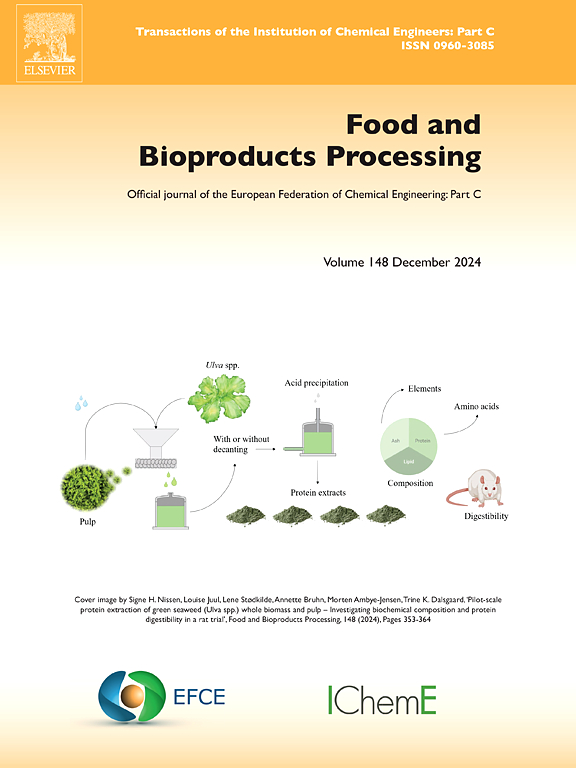Techno-economic assessment and modeling of large-scale process for biofortified selenized chickpea flour production (Cicer arietinum L.) as a functional ingredient
IF 3.4
2区 农林科学
Q2 BIOTECHNOLOGY & APPLIED MICROBIOLOGY
引用次数: 0
Abstract
Selenium, a crucial trace mineral with antioxidant properties, supports immune function, hormone metabolism, and reduces inflammation. Biofortifying chickpeas with selenium enhances their nutritional value and health benefits. Using SuperPro Designer V.12, a virtual model was developed to design and analyze the large-scale production of selenium-enriched chickpea (Cicer arietinum L.) flour. The process includes raw material pre-treatment, soaking in a selenite solution, germination, drying, grinding, sieving, and packaging. The feasibility of producing selenized chickpea flour was evaluated through five economic indicators (ROI, payback time, gross margin, IRR, and NPV) by varying eight process parameters: production rate, selling price, equipment costs, labor costs, raw material costs, selenium concentration, drying equipment, and water usage. The designed process results in a batch time of 71.75 h producing 130 batches annually. Analysis of three different setups, evaluating the distribution of fixed capital and operating costs under various production rates, showed that processing 40 tons of chickpeas per batch with drum drying and water treatment significantly reduces unit production costs, enhancing profitability at selling prices below $10 USD/kg. This preliminary analysis supports decision-making by assessing the feasibility and benefits of large-scale selenized chickpea flour production. Although based on lab-scale experiments, it highlights key challenges and potential advantages before extensive and costly experimental studies. Future research should focus on diversifying biofortified micronutrients, improving sensory properties, and conducting long-term studies, establishing selenium-biofortified chickpea flour as an economic strategy to enhance public health.
生物强化硒化鹰嘴豆粉(Cicer arietinum L.)功能成分大规模生产工艺的技术经济评价与建模
硒是一种重要的微量矿物质,具有抗氧化特性,支持免疫功能,激素代谢,减少炎症。用硒生物强化鹰嘴豆可以提高其营养价值和健康益处。利用SuperPro Designer V.12开发虚拟模型,对大规模生产富硒鹰嘴豆面粉进行设计和分析。该工艺包括原料预处理、亚硒酸盐溶液浸泡、发芽、干燥、研磨、过筛和包装。通过对生产率、销售价格、设备成本、人工成本、原料成本、硒浓度、干燥设备、用水量等8个工艺参数的变化,通过ROI、回收期、毛利率、IRR、NPV等5个经济指标对鹰嘴豆粉硒化生产的可行性进行评价。设计工艺的结果是批时间为71.75 h,每年生产130批。对三种不同装置的分析,评估了不同生产率下的固定资本分配和运营成本,结果表明,采用滚筒干燥和水处理每批处理40吨鹰嘴豆可显著降低单位生产成本,在售价低于10美元/公斤时提高盈利能力。该初步分析通过评估大规模硒化鹰嘴豆粉生产的可行性和效益来支持决策。虽然基于实验室规模的实验,但在广泛和昂贵的实验研究之前,它强调了关键的挑战和潜在的优势。未来的研究应侧重于多样化的生物强化微量营养素,改善感官特性,并进行长期研究,建立硒生物强化鹰嘴豆粉作为一种经济策略,以提高公众健康。
本文章由计算机程序翻译,如有差异,请以英文原文为准。
求助全文
约1分钟内获得全文
求助全文
来源期刊

Food and Bioproducts Processing
工程技术-工程:化工
CiteScore
9.70
自引率
4.30%
发文量
115
审稿时长
24 days
期刊介绍:
Official Journal of the European Federation of Chemical Engineering:
Part C
FBP aims to be the principal international journal for publication of high quality, original papers in the branches of engineering and science dedicated to the safe processing of biological products. It is the only journal to exploit the synergy between biotechnology, bioprocessing and food engineering.
Papers showing how research results can be used in engineering design, and accounts of experimental or theoretical research work bringing new perspectives to established principles, highlighting unsolved problems or indicating directions for future research, are particularly welcome. Contributions that deal with new developments in equipment or processes and that can be given quantitative expression are encouraged. The journal is especially interested in papers that extend the boundaries of food and bioproducts processing.
The journal has a strong emphasis on the interface between engineering and food or bioproducts. Papers that are not likely to be published are those:
• Primarily concerned with food formulation
• That use experimental design techniques to obtain response surfaces but gain little insight from them
• That are empirical and ignore established mechanistic models, e.g., empirical drying curves
• That are primarily concerned about sensory evaluation and colour
• Concern the extraction, encapsulation and/or antioxidant activity of a specific biological material without providing insight that could be applied to a similar but different material,
• Containing only chemical analyses of biological materials.
 求助内容:
求助内容: 应助结果提醒方式:
应助结果提醒方式:


